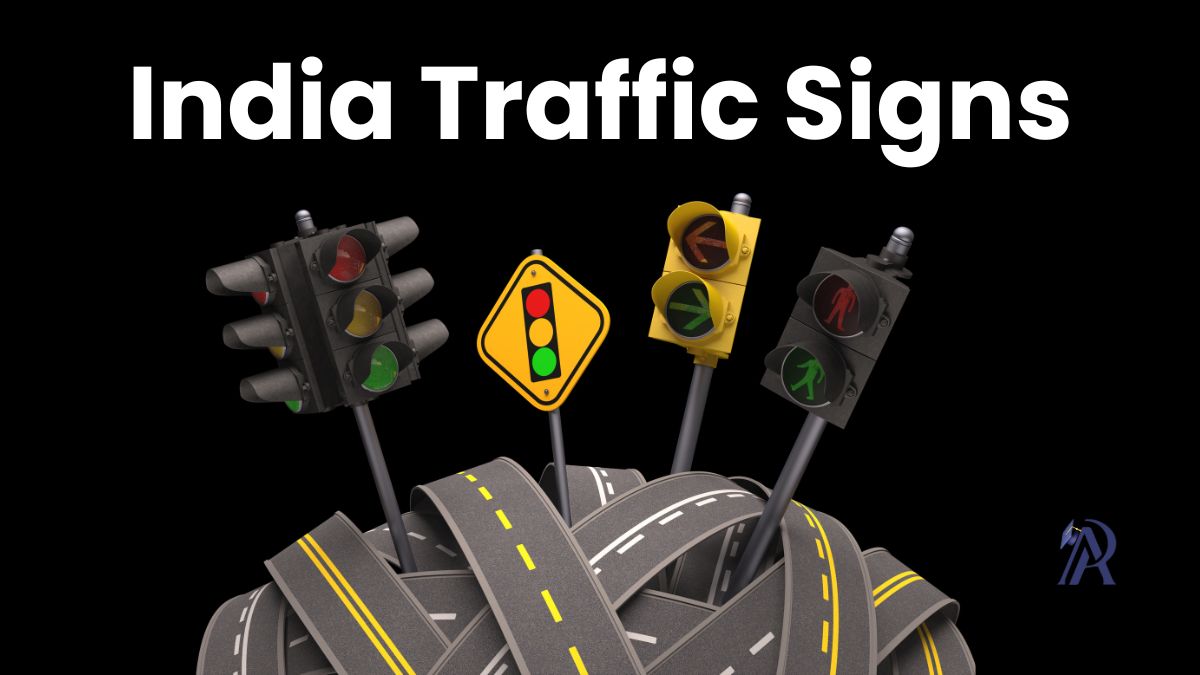India Traffic Signs 2025: All Types, Size, Importance, Road Safety and Guidelines
India Traffic Signs 2025: Traffic signs and Traffic Signals are vital components for safe driving in any town or city. This foundational knowledge is essential for anyone operating a bike, scooter, or car. Road signs come in various forms, including exclamation marks, arrows, numbers, and human figures, and are painted in a range of colors such as yellow, red, and blue. Understanding these signs is crucial as they play a crucial role in guiding and regulating traffic flow. Sadly, many road accidents in India occur due to the disregard of traffic rules.
The Road Act and the Road Traffic Act stipulate the design, placement, and other specifications of road signs to ensure uniformity and clarity. These signs not only help control traffic but also inform drivers and pedestrians about traffic laws, facilitating safe and efficient navigation of roads. Efforts have been made to simplify the design and messaging of these signs for better comprehension by all road users. For additional information on traffic signs, you can visit our website admissionportal.in for a comprehensive guide on this topic.
Table of Contents
India Traffic Signs and Road Signs 2025
India Traffic Signs: Traffic and road signs are essential visual cues that play a crucial role in guiding and regulating the flow of traffic on roads. These signs, simple in their design yet rich in their significance, are the visual representations of the rules set forth by the Ministry of Road Transport and Highways. They serve as beacons of information for drivers and pedestrians alike, ensuring a harmonious and safe journey for all on the roads. Adherence to these signs is paramount, as they not only facilitate a smooth drive but also contribute to overall road safety.
Mandatory, Cautionary, and Informatory Sign
The plethora of road and traffic signs found along our roadways each serves a distinct purpose, designed to communicate specific messages to road users. Categorized into three main groups—Mandatory, Cautionary, and Informatory Signs—these signs are strategically placed to convey imperative information to individuals navigating the roads. Mandatory signs, characterized by their authoritative nature, issue commands that must be followed to avoid legal repercussions. Cautionary signs, on the other hand, alert drivers to potential hazards or dangers ahead, prompting them to exercise heightened vigilance and care. Meanwhile, Informatory signs serve as informational guides, furnishing road users with knowledge about their surroundings or upcoming routes.
Delving deeper into each category offers a comprehensive understanding of the intricacies and nuances of road signage. Mandatory signs, with their unequivocal instructions, are instrumental in upholding traffic laws and promoting order on the roads. Informatory signs, with their informative content, equip individuals with the knowledge necessary to navigate unfamiliar terrains with confidence. Together, these signs form an integrated system that fosters road safety and facilitates efficient transportation networks.
Types of Road Signs: Information and Examples
Road signs are an essential aspect of traffic regulations, guiding drivers and pedestrians alike on the roads. There are five main categories of road signs: instruction signs, regulatory signs, warning signs, guide signs, and auxiliary signs, all designed to communicate crucial information to road users. Instruction signs provide specific directions or information, while regulatory signs enforce traffic laws and regulations. Warning signs alert drivers to potential hazards or changes in road conditions, ensuring their safety on the road. Auxiliary signs complement the main signage system, providing additional information or warnings to enhance road safety. Lastly, Guide signs offer navigational assistance, directing travelers to destinations or points of interest.
Examples of Mandatory India Traffic Signs
The mandatory traffic signs in India serve as crucial guides for drivers on the road, ensuring safety and order in the bustling streets. Each sign plays a vital role in regulating traffic flow from the bright red “Stop” sign, indicating an immediate halt, to the “Give Way” sign prompting drivers to yield to oncoming traffic. The “Straight Prohibitor No Entry” sign symbolizes a restricted area, while “Pedestrian Prohibited” warns that walking is not allowed in that zone. “Horn Prohibited” restricts honking, emphasizing a quieter environment (No Souud Zone – School, Hospitals Area).
“No Parking” and “No Stopping or Standing” signs delineate areas where vehicles cannot be stationary, maintaining a smooth flow of traffic. “Speed Limited” signs enforce designated speed limits, promoting road safety. Cautionary signs like “Right Hand Curve” and “Left Hand Curve” alert drivers about upcoming turns, while “Right Hair Pin Bend” and “Left Hair Pin Bend” mark sharp bends ahead. “Narrow Road Ahead” prepares drivers for tight paths, ensuring careful navigation through confined spaces. Each sign is a silent messenger on the roads, guiding motorists towards safe and responsible travel.
India Traffic Signs are Displayed in Different colours
India Traffic Signs are displayed in different colours to convey different messages to road users. The bright hues stand out against the backdrop of roads and streets to capture drivers’ attention and communicate crucial information effectively. A black and yellow traffic sign, for example, signifies a warning message, alerting drivers to upcoming hazards and potential dangers on the road ahead. Ignoring or failing to follow these signs can have serious consequences, such as contributing to traffic congestion, incurring hefty fines, or being involved in unexpected road accidents. To promote road safety and reduce risks for all road users, it is essential to adhere to traffic regulations and guidelines.

